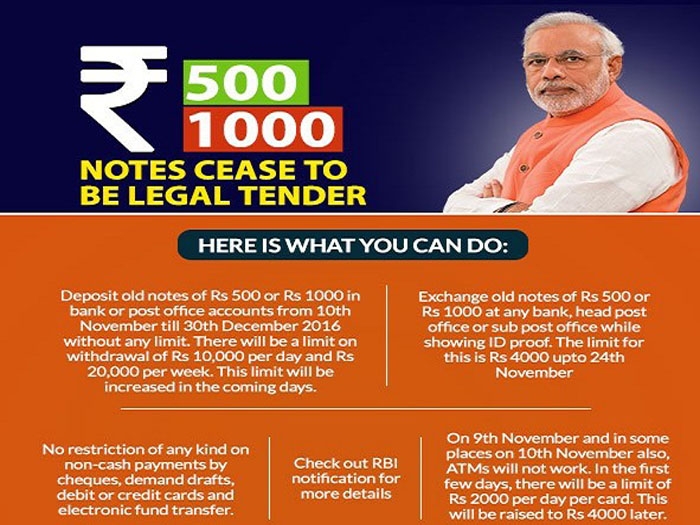Demonetization – Modi’s proud socialist moment

November 8, 2016, will perhaps go down in history as the day India ushered in the most comprehensive finance sector reform that transformed the country as never before. Now, ten days later, it can be said, that it has almost been pulled off with aplomb with the least possible hardship to people. There is no doubt that there are queues in front of the banks, the rural economy has to get used to the fast changing monetary reform and that there is going to be a temporary fall in the demand in the retail sector.
Making 86 percent of the currency in circulation illegal in one stroke, the secrecy and shock in a country where still half of the population is outside the banking system and habitually hoard hard earned income and loathe the idea of going to the bank is itself revolutionary. And of the 14.90 lakh crore high denomination notes almost 70 percent was kept as black money, hidden away from the banking system by those who have stashed away the national wealth.
Those opposing the demonetization in the name of the suffering of the poor have not produced a single coherent argument to support their dissent. All agree that corruption has to be fought. They also agree that black money is the biggest source of corruption. It leads to inequality and price rise and devaluing the currency. Equally worrying is the presence of huge chunks of counterfeit currency funding terror, crime and subversion in the country.
All agree that the share of counterfeit money in circulation is almost equal to the black money in circulation. The fact that Kashmir has been peaceful for over ten days with 100 per cent attendance in schools for exams and the stealth wealth of Maoists has been reduced to mere paper bolster the purpose of the surgical strike.
Prime Minister Narendra Modi’s clean-up operation has been hailed as a bold and long overdue step by most well-meaning economists including former RBI governors K. Subba Rao, Rangarajan, Dr Meghnad Desai and Dr Surjit Bhalla. The opposition says that people in remote areas who have no access to the banking system are the worst sufferers. Here it is worth mentioning the unique manner in which Assam government tackled the problem of over a million tea garden workers in the remotest area.
The tea garden employees have traditionally been averse to become account holders. In the area spread over thousands of miles, some four million people working in sprawling tea gardens have been getting weekly wages in cash for centuries. When Prime Minister Modi announced demonetization and restrictions on the cash transaction, the biggest concern for the state government was the tea garden employees, said V K Pipersenia, Chief Secretary of Assam.
With the help of the centre, he said, the state government got special permission to withdraw sufficient money to pay for the tea garden workers in cooperation with the private tea companies. The companies were asked to deposit their cheque in the state government account and an equal amount was withdrawn by the state government and facilitated the uninterrupted disbursal of wages to the workers.
In fact, within a couple of days things became normal in the entire Assam on the currency front. This unique example is a lesson for other States also. Pipersenia says soon all these people will become bank account holders taking a big leap towards financial inclusion. Over a thousand outlets of banks in various forms will come alive in the area. In fact, under Jan Dhan Yojna, a number of bank accounts were opened in the last two years than the number of accounts since independence.
If the concern is the welfare of the people, demonetization is the most people-friendly step ever taken by any government ever in history. In a society where 59 percent of the national wealth is in the hands of just one percent rich people and the poorest 10 percent of the population’s share in the national wealth is only 0.2 percent and the gap between the rich and the poor rose from 1480 times to 2450 times between 2004 and 2014, according to a recent study, Narendra Modi acted as a great leveler. The gap, the unacceptable level of inequality in the society has to be corrected, and this is a solid step in that direction.
With this, the Prime Minister has proclaimed his commitment to what Dr. B R Ambedkar called “social and economic equality” along with political equality enshrined in the constitution. With this, the role of big money and black money in politics will come down. It will become a level playing field for all political aspirants - attracting better talent in politics.
This will bring prices and lending rates down. This is bound to encourage investment. This will stop the use of black and fake money in crime and terror activities and make life safer for the common man. The drive on black money will bring more revenue to the government’s kitty making it possible to spend more on infrastructure, welfare schemes, health and education.
The days of capitation fees are over. Education will no more be business as usual. Modi’s dream of a house for all and 50 million free gas connections to BPL families would not have been possible with the existing levels of inflated realty prices. Modi has positioned as the messiah of the poor.
The road map the government has an objective of a creation of an egalitarian social structure, eliminating power brokers, black money and corruption with a focus on equitable distribution of wealth.
Demonetization marks the beginning of transparency in public spending and, end to splurge and vulgar extravaganza of a few at the cost of the rest.
